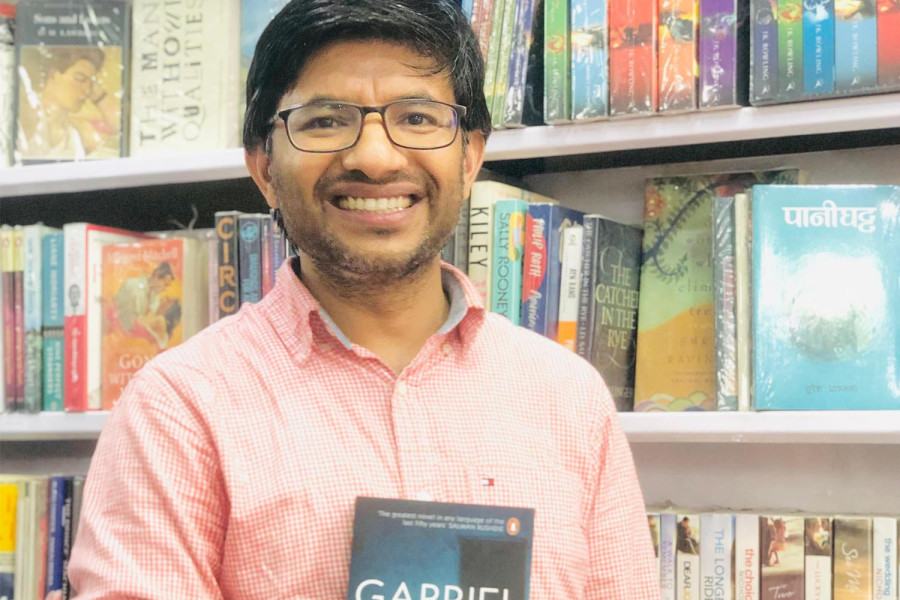Culture & Lifestyle
I write to heal my soul
Writer Suresh Pranjali says that despite the rise of visual content, novels remain valuable for their deep storytelling.
Sanskriti Pokharel
Suresh Pranjali wears many hats. He moves fluidly between literature, journalism, and music. His debut novel ‘Tuin’ (2013) tells the stories of the Karnali people who struggled during the Maoist insurgency. His second novel, ‘Paanighatta’ (2022), explores Rodhi culture and the Lahure tradition in the Gandaki region.
Outside of fiction, Pranjali has contributed several political commentaries to national newspapers for many years. He has penned dozens of songs spanning folk, folk-pop and modern genres. ‘Birsiyon Ki Kunni’ earned him the Kalika Music Award in 2007.
Currently, he is working on his third novel.
In this conversation with the Post’s Sanskriti Pokharel, Pranjali discusses how combining visuals with narration can help attract and retain readers today.
Why do you write?
Examining society and its inhabitants also means accumulating painful experiences. Such experiences need to be released from the inner soul. So, I write mostly for healing.
Moreover, I consistently aim to address genuine societal issues, exploring their authentic narratives and intricate dynamics. In the process, my writing naturally carries a social message. I also draw on my memories, striving to portray them in detail.
‘Paanighatta’ explores Rodhi culture and the Lahure tradition. What drew you to these themes?
The soil I was born in and the society I grew up in bear witness to Rodhi culture’s beauty and the Lahure tradition's necessity. Perhaps it was this very society that gave me the strength to write about these themes.
While the Lahure culture remains unchanged in the Gandaki region, Rodhi culture is on the brink of extinction within the Gurung community. My purpose in writing ‘Paanighatta’ is to preserve the cultural richness of Gurung traditions through literature and to capture the era that the Gandaki region experienced during the 1970s and 1980s.
Which authors or books have influenced you most in your professional journey?
‘Bhagavat Gita’ and ‘Autobiography of a Yogi’ by Paramahansa Yogananda have influenced me a lot in my journey. The ‘Gita’ underscores the significance of achieving one’s duties and responsibilities without expecting results. We know that contemporary society measures success by material achievements. However, ‘Gita’’s teachings have inspired me to focus on inner peace and emphasise actions rather than merely ensuing outcomes.
Similarly, ‘Autobiography of a Yogi’ has offered a spiritual perspective on my journey as the book underlines the importance of self-respect and willpower.
You’ve written two novels a decade apart. Why the long gap? Was it fear of repetition, lack of time, or something more personal?
The stories I write are rooted in social reality. My goal is not just to tell a story but to capture the spirit of the time in which society exists. For me, writing is like a laboratory, where creative experiments and trials take place. The raw materials for storytelling demand deep, sustained research into society and its layers.
Writing involves a long and thoughtful exploration of societal dynamics. I devote much of my time to the pre-writing phase—learning the language, immersing myself in cultural settings, shaping the raw materials, building the plot and setting, choosing and studying characters, and collecting ethnographic details. Before the actual writing begins, I make sure I have everything I need to build the world of the story.
I also spend ample time rewriting the manuscript. The more you rewrite, the more refined and stronger the book becomes.
Do you sometimes think your identity as a songwriter eclipses your writing, or do you view them as complementary?
I write about what I see and experience most deeply. To me, songs and other literary works—whether fiction or non-fiction—are similar in their essence. They differ only in form, not in purpose. Both serve as mediums to connect with audiences and express emotions or ideas.
Some feelings can be captured perfectly in a song or a few lines of lyrics. Others require the depth and space that only longer narratives—like fiction or creative non-fiction—can offer. That’s why I see these forms of expression not as separate but as complementary.
In a time when AI is capable of creating lyrics and melodies, do you worry that human songwriting is becoming less valuable?
It is alarming that AI can generate songs in a fraction of a seconds. However, I don’t believe it will completely replace human songwriters because AI does not have the humanlike quality for profound creativity and may not have the ‘heartlike source’ to release pure emotions.
In the current market, as readers shift towards visual content and social media, what significance does writing a novel hold in 2025?
Visual content and social media can’t replace the value of deeper engagement and contemplation, like reading a novel and diving into the world of imagination through characters. Additionally, combining visuals with narration and exploring new storytelling methods can engage more readers.
Suresh Pranjali’s five book recommendations
Autobiography of a Yogi
Author: Paramahansa Yogananda
Publisher: The Philosophical Library
Year: 1946
This autobiography by Yogananda introduced me to meditation. It also serves as a therapeutic guide for inner healing and self-growth.
Humankind: A Hopeful History
Author: Rutger Bregman
Publisher: Little, Brown and Company
Year: 2019
Bregman offers a fresh perspective on 200,000 years of human history, questioning humanity’s perceived arrogance and wickedness.
Abstract Chintan: Pyaj
Author: Shankar Lamichhane
Publisher: Sajha Prakashan
Year: 1967
Lamichhane uses an onion as a metaphor to reveal the layered meanings of life, portraying it as a playhouse of art.
Srikanta
Author: Sarat Chandra Chattopadhyay
Publisher: Oxford University Press
Year: 1922
This Bengali classic, translated into English, tells a love story set before the partition of India, with powerful female characters.
Milkman
Author: Anna Burns
Publisher: Faber & Faber
Year: 2018
Burn’s historical and psychological novel beautifully portrays Northern Irish socio-politics, giving a voice to gender-based violence.




 22.65°C Kathmandu
22.65°C Kathmandu















